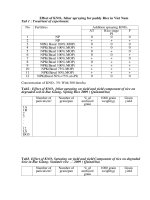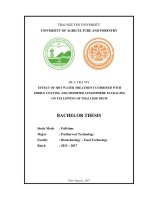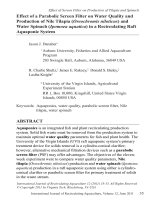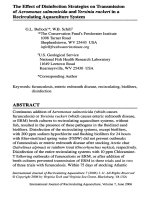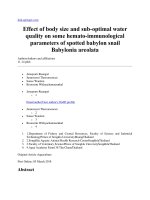Effect of feeding Japan Hlo (Mikania micrantha Kunth.) as unconventional protein source on haemato-biochemical profiles of growing large white yorkshire pigs (LWY) in mizoram
Bạn đang xem bản rút gọn của tài liệu. Xem và tải ngay bản đầy đủ của tài liệu tại đây (282.4 KB, 8 trang )
Int.J.Curr.Microbiol.App.Sci (2018) 7(7): 3560-3567
International Journal of Current Microbiology and Applied Sciences
ISSN: 2319-7706 Volume 7 Number 07 (2018)
Journal homepage:
Original Research Article
/>
Effect of Feeding Japan Hlo (Mikania micrantha Kunth.) as Unconventional
Protein Source on Haemato-biochemical Profiles of Growing
Large White Yorkshire Pigs (LWY) in Mizoram
Eneth Lalhuthangi and Rajat Buragohain*
Department of Animal Nutrition, College of Veterinary Sciences and Animal Husbandry,
Central Agricultural University, Selesih, Aizawl, Mizoram – 796015, India
*Corresponding author
ABSTRACT
Keywords
Mikania micrantha
Kunth., Protein
source, Soyabeal
meal, LWY pigs,
Mizoram
Article Info
Accepted:
26 June 2018
Available Online:
10 July 2018
The study was to assess the effect of feeding Japan hlo (Mikania micrantha Kunth.) in
‘meal form’ (JLM) as protein substitute on haemato-biochemical profiles of growing LWY
pigs. Sixteen weaned LWY pigs were assigned four dietary treatments with JLM at 0%,
5%, 10% and 15% level as substitute of soyabean meal (SBM) at an amount on equivalent
protein basis for a period of 75 days. For haemato-biochemical parameters, blood were
collected at 0, 30th, 60th, 75th days of experiment and analysed utilising commercial
analytical kits and following standard procedures. The results revealed no significant
differences (P>0.05) in both haematological and biochemical parameters among the
treatment groups up to 15% JLM inclusion level. The parameters were observed to be
within normal range in all the groups, although were variable. Thus, it was concluded that
Japan hlo (Mikania micrantha Kunth.) in ‘meal form’ can be utilised up to 15% level as
protein source replacing soyabean meal (SBM) at an amount on equivalent protein basis in
growing LWY pigs of Mizoram.
Introduction
Piggery contributes substantially to economic
sustainability of rural farmers in Mizoram.
About 69.33% of the total livestock
population of the state is pigs (Economic
Survey Mizoram, 2017-18) and is one of the
prime sources of livelihood and employment
avenue of the state. The pig rearing practice in
Mizoram is mainly of backyard type
characterised by extensive uses of local
vegetation, agro-wastes, and household and
kitchen wastes (Kumaresan et al., 2006).
Amongst the various local unconventional
feedstuffs, ‘Japan hlo’ (Mikania micrantha
Kunth.) is one of the commonly used feed
resource by the pig farmers of the state for its
abundant availability throughout the year
(Buragohain, 2012 and 2013). As the
conventional ingredients are expensive, the
search for alternative feed sources is the need
of the hour to increase production efficiency
of pigs (Nguyen et al., 2010). In this regard,
Japan hlo may be a promising alternative to
the conventional ingredients of pigs raised
under rural production system in Mizoram. It
3560
Int.J.Curr.Microbiol.App.Sci (2018) 7(7): 3560-3567
is a good source of protein (21.76% crude
protein on dry matter basis) with the lysine,
methionine, aspartate, threonine, leucine,
phenylalanine and alanine levels at 6.90, 2.40,
12.0, 5.70, 9.50, 6.10, 6.30 gm%, respectively
(Hock-Hin Yeoh, 1992).
In the present study, an attempt was made to
elucidate the effect of feeding Japan hlo in
‘meal form’ at different levels as protein
source substituting the conventional soyabean
meal on equivalent protein basis on haematobiochemical profiles of growing LWY pigs in
Mizoram.
Materials and Methods
The study was carried out in the Instructional
Livestock Farm Complex (ILFC) of College
of Veterinary Sciences & Animal Husbandry,
Central Agricultural University, Selesih,
Aizawl, Mizoram.
Sixteen weaned pure breed LWY piglets
(average body weight 20.10±3.24 to
20.63±3.75 kg) were randomly selected from
the herd maintained at ILFC, College of
Veterinary Sciences & Animal Husbandry,
Central Agricultural University, Selesih,
Aizawl, Mizoram and were divided into four
experimental groups (G - I, II, III and IV) with
four piglets in each group.
The experimental pigs were housed
individually under intensive management with
provision for individual feeding and watering.
The feed was provided ad libitum and
drinking water was made available all the
time. The feeding trial was carried out for 75
days with 7 days adaptation period at the start
of the experiment.
For
haematological
and
biochemical
parameters, blood were collected from 3
piglets of each group at 0, 30th, 60th, 75th of
experiment following standard procedures.
The experimental animals were restrained in
ventro-dorsal position and the blood was
collected directly from anterior vena-cava
under aseptic condition. For biochemical
parameters, serum was immediately separated
by centrifugation and stored at -200C till
further
analysis.
For
haematological
parameters, blood was collected in sterile
tubes having EDTA as anti-coagulant.
Haematological parameters were analysed
following standard laboratory procedures,
whereas the biochemical parameters were
estimated using commercial analytical kits of
Coral India Limited.
The data obtained were tabulated and
subjected to statistical analysis as per the
methods of Snedecor and Cochran (1994).
Results and Discussion
The Japan hlo (Mikania micrantha Kunth.)
was collected from different places in and
around Selesih, Aizawl, Mizoram were pooled
together and sun- dried before milling using
grinding machine to prepare JLM.
The
nutritional
composition
of
the
experimental rations fed to different
experimental groups is depicted in table 2.
Haematological parameters
Four experimental isonitrogenous rations were
formulated (NRC, 1998) where Japan hlo
(Mikania micrantha kunth.) meal (JLM) was
incorporated at the rate of 0%, 5%, 10% and
15% level by replacing soyabean meal(SBM)
at an amount on equivalent protein basis
(Table 1).
Haematology can be important in early
identification of physical illness or disease.
Variations in size, shape and number of blood
cells give early insight into the general
functioning of blood and bone marrow.
Haematological parameters are indicators of
3561
Int.J.Curr.Microbiol.App.Sci (2018) 7(7): 3560-3567
the physiological status of animals (Khan and
Zafar, 2005) and animals with good blood
composition show good performance (Isaac et
al., 2013).
Haemoglobin (Hb) level is primarily used for
assessment of anaemia or its reverse,
polycythaemia. In the present study, the Hb
levels in all the groups were within the normal
range throughout the experimental period
indicating that feeding of JLM had no
significant effect on Hb level of growing
LWY pigs. The values were variable and
ranged from 15.80±0.06 to 16.33±0.19
(g%/dl) for G-I i.e. without JLM in the ration
and 15.73±0.09 to 16.27±0.19 (g%/dl) in JLM
supplemented groups. However, Hb levels
were comparatively lower in G-III and G-IV
as compared to G-I and G-II. This might be
effect of JLM on metabolic process of the
animals.
Packed cell volume (PCV) measures the
percentage of red blood cells in a standard
volume of blood and is used to determine the
presence and type of anaemia. In the present
study, the PCV ranged from 29.48±0.34 to
30.40±0.17 in Gr. I and 29.40±0.12 to
31.40±0.10 in treatment groups. As no
significant differences was observed and the
values were within the normal range, it
indicated that JLM had no significant effect on
PCV level up to 15% feeding level.
Low total leucocytes count (TLC) indicates
suppression of immune system of animals.
The TLC levels were found to be within
normal range and therefore was concluded that
JLM did not impart any stress and impair
immune system of the growing LWY pigs.
A low RBC count indicates anaemia, excess
body fluid and blood loss, whereas a high
count occurs in dehydration and in
polycythaemia. In the present study, statistical
analysis revealed no significant differences in
TEC of pigs of different treatment groups. It
might be the indication that JLM can be
included up to 15% level in growing LWY
pigs without any adverse effects in the
synthesis of RBC of blood. However, TEC
was comparatively lower at 10% and 15%
JLM inclusion level (Table 3).
Table.1 Ingredient composition of the experimental rations with JLM at varying levels
Ingredients
Maize
Rice Polish
Soyabean Meal
Fish Meal
Mineral Mixture
Common salt
JLM
Total
Cost/Kg (Rs.)
G-I
51
20
22
4
2.5
0.5
0
100
30.63
G-II
49.4
18
19.6
5
2.5
0.5
5
100
29.02
3562
G-III
42.5
22
17.2
5.3
2.5
0.5
10
100
26.97
G-IV
41.25
20
14.75
6
2.5
0.5
15
100
25.28
Int.J.Curr.Microbiol.App.Sci (2018) 7(7): 3560-3567
Table.2 Nutritional composition (% DM basis) of rations of experimental groups
Nutrient
DM (%)
CP (%)
CF (%)
EE (%)
TA (%)
NFE (%)
OM (%)
*ME (kcal/kg)
*Lysine (%)
*Methionine (%)
* Calculated values.
G-I
9.40
8.06
4.32
3.87
12.24
61.51
87.76
3311
1.02
0.38
G-II
89.60
18.08
5.07
3.48
11.75
61.62
88.25
3208
0.96
0.36
G-III
89.50
18.07
6.43
3.64
12.98
58.88
87.02
3116
0.90
0.36
G-IV
89.40
17.99
7.18
3.79
12.66
58.38
87.34
3014
0.83
0.34
Table.3 Haematology in LWY pigs fed JLM at varying levels
Day
G-I
G-II
0
15.80±0.06
15.90±0.25
G-III
Haemoglobin (%)
15.80±0.06
30th
16.00±0.10
16.07±0.24
15.97±0.13
15.77±0.38
60th
16.30±0.15
16.27±0.19
15.73±0.09
16.07±0.24
75th
16.33±0.19
16.20±0.30
15.90±0.06
16.17±0.19
0
29.90±0.06
29.75±0.20
PCV (%)
29.84±0.19
29.48±0.07
29.60±0.35
29.40±0.12
29.90±0.06
30.00±0.06
30.40±0.17
31.40±0.10
30.25±0.32
30.22±0.04
29.48±0.34
29.87±0.44
29.92±0.45
29.78±0.17
5.50±0.15
5.47±0.15
TLC (1000/ml)
5.45±0.10
5.44±0.08
5.65±0.09
5.43±0.01
5.42±0.10
5.33±0.19
5.80±0.06
5.96±0.06
6.20±0.06
5.90±0.25
6.33±0.13
6.47±0.03
6.28±0.12
6.49±0.24
3.07±0.08
2.94±0.02
TEC (1000/ml)
2.91±0.09
2.92±0.03
3.00±0.08
3.08±0.01
2.92±0.08
2.99±0.03
3.09±0.06
3.01±0.09
2.96±0.06
2.97±0.03
2.99±0.05
3.06±0.08
3.07±0.03
3.09±0.06
th
30
th
60
th
75
0
th
30
th
60
th
75
0
th
30
th
60
th
75
Means bearing different superscript (a, b, c) in a row differ significantly (P<0.05)
3563
G-IV
15.83±0.17
p-value
ns
0.963
ns
0.835
ns
0.166
ns
0.522
ns
.268
ns
.170
ns
.469
ns
.840
ns
0.986
ns
0.315
ns
0.271
ns
0.713
ns
0.322
ns
0.498
ns
0.333
ns
0.618
Int.J.Curr.Microbiol.App.Sci (2018) 7(7): 3560-3567
Table.4 Biochemical parameters in LWY pigs fed JLM in Mizoram
Day
0
th
30
th
60
th
75
0
th
30
th
60
th
75
0
th
30
th
60
th
75
0
th
30
th
60
th
75
0
th
30
th
60
th
75
0
th
30
th
60
th
75
0
th
30
G-I
G-II
G-IV
75.00±0.58
G-III
AST (IU/L)
64.82±2.07
66.81±4.73
75.56±1.99
73.53±1.36
75.73±2.04
76.00±0.57
85.61±0.11
85.03±2.35
84.31±1.57
84.87±1.43
90.95±0.24
92.71±1.17
92.35±1.13
91.26±0.17
6.75±0.26
7.45±1.18
ALT (IU/L)
8.20±1.56
9.05±0.72
9.95±0.66
11.15±0.89
10.05±1.01
10.15±0.61
12.61±0.33
12.67±0.0.08
12.88±0.17
13.53±0.56
14.44±1.13
15.03±0.87
16.75±1.19
15.32±1.00
9.90±0.17
10.20±0.92
ALP (IU/L)
10.13±0.48
9.87±0.18
12.29±0.39
12.58±0.45
13.23±0.34
13.29±0.12
20.02±0.39
20.05±0.36
20.24±0.86
20.23±0.69
30.29±0.99
31.56±0.42
31.36±0.64
31.01±0.02
93.33±0.83
93.37±0.05
Glucose (mg/dl)
93.32±0.39
92.90±0.13
92.20±0.11
92.05±0.48
89.89±1.72
89.72±1.02
90.16±0.68
89.16±0.68
88.51±0.55
88.46±0.56
89.05±0.81
87.14±1.30
89.19±0.66
88.71±0.47
8.08±0.11
Total protein (mg/dl)
8.39±0.13
8.41±0.28
8.67±0.12
8.63±0.04
8.59±0.07
8.74±0.05
8.54±0.11
8.79±0.02
8.83±0.04
8.76±0.08
8.69±0.05
8.86±0.03
8.83±0.01
8.82±0.08
8.79±0.07
4.94±0.02
4.86±0.04
Albumin (g/dl)
4.90±0.01
4.91±0.05
5.03±0.04
5.04±0.02
5.04±0.02
5.02±0.11
5.12±0.05
5.28±0.06
5.13±0.02
5.25±0.11
5.02±0.01
5.57±0.24
5.55±0.20
5.64±0.26
0.88±0.01
0.91±0.03
Creatinine (mg%)
0.88±0.01
0.91±0.02
0.96±0.01
0.95±0.02
0.99±0.01
1.01±0.02
3564
66.19±3.78
p-value
ns
0.185
ns
0.694
ns
0.950
ns
0.419
ns
0.489
ns
0.711
ns
0.274
ns
0.499
ns
0.960
ns
0.190
ns
0.990
ns
0.537
ns
0.877
ns
0.244
ns
0.258
ns
0.376
ns
0.209
ns
0.305
ns
0.455
ns
0.845
ns
0.414
ns
0.990
ns
0.251
ns
0.194
ns
0.465
ns
0.137
Int.J.Curr.Microbiol.App.Sci (2018) 7(7): 3560-3567
th
60
th
75
0
th
30
th
60
th
75
0
th
30
th
60
th
75
0
th
30
th
60
th
75
0.98±0.01
1.03±0.03
1.03±0.05
1.17±0.10
1.05±0.08
1.28±0.04
1.24±0.03
1.24±0.14
33.25±0.76
33.71±0.87
BUN (g%)
33.17±0.51
32.93±0.65
34.54±0.69
34.69±0.74
35.92±0.89
35.25±0.59
35.97±0.57
36.83±1.11
37.06±0.79
37.09±0.81
36.48±0.54
37.45±0.73
39.21±1.28
38.24±0.72
71.01±0.28
Cholesterol (mg/dl)
71.72±0.21
71.80±0.98
72.91±1.71
72.95±1.25
74.36±1.18
74.32±0.58
74.25±0.69
73.29±0.59
73.41±1.35
72.75±0.83
72.47±1.26
75.34±0.58
74.11±2.83
72.23±1.26
71.19±1.03
122.08±0.88
Triglycerides (mg/dl)
123.24±0.84
121.91±0.69
121.99±0.77
122.65±1.37
121.96±0.68
122.03±1.17
121.35±0.55
122.69±0.80
122.04±1.05
121.43±0.87
120.52±0.38
121.93±0.97
120.76±0.99
120.36±0.76
119.97±0.25
ns
0.189
ns
0.266
ns
0.887
ns
0.565
ns
0.764
ns
0.226
ns
0.623
ns
0.698
ns
0.908
ns
0.354
ns
0.622
ns
0.837
ns
0.343
ns
0.399
Means bearing different superscript (a, b, c) in a row differ significantly (P<0.05)
In a feeding trial in growing LWY pigs,
Fasuyi et al., (2013) reported that Tithonia
diversifolia (wild sunflower) leaf meal could
be incorporated up to 20% level as protein
supplement without significant (P<0.05)
effects in haematological parameters namely
TLC, and could be a suitable health diet at
10% level to combat some fatty acid
metabolic diseases in pigs. Olayeni et al.,
(2012) also reported no significant differences
(P>0.05) in haemoglobin, packed cell volume,
total red blood cell count and mean
corpuscular haemoglobin level in pigs when
fed wild sunflower (Tithonia diversifolia) leaf
meal.
Blood biochemical profile
globulin, creatinine and urea) are indicators of
adequacy of protein in terms of quality and
quantity in the diet. These parameters show
whether there are protein malnutrition,
alterations in the dietary intake of protein and
pattern of utilization, and possibly the extent
of muscle wastage and subsequent
degradation of muscle (Eggum, 1970). Other
serum metabolites (glucose, triglyceride and
cholesterol) indicate the efficiency of
utilisation of metabolisable energy in a given
ration (Fanimo, 1991 and Anderson, 1983).
High level of AST and ALT indicates muscle
damage, heart muscle damage, liver damage,
toxin ingestion, inflammation and various
metabolic disorders, whereas their low level
indicates starvation or malnutrition (Table 4).
Biochemical profile assesses the function of
internal organs, measures the electrolytes and
identifies
the
levels
of
circulating
enzymes.The serum metabolites (albumin,
In the present study, both the AST and ALT
levels were within the normal range besides
without any significant differences (P>0.05)
among the groups throughout the study
3565
Int.J.Curr.Microbiol.App.Sci (2018) 7(7): 3560-3567
period.
High level of alkaline phosphatase (ALP)
indicates bile duct obstruction, liver disease
etc. and low level is indication of starvation or
malnutrition. As the ALP levels were within
normal range and no significant differences
(P>0.05) was recorded, it can be opined that
JLM can safely be incorporated up to 15%
level without any adverse effects on body
metabolism and on the liver of LWY pigs.
High glucose level indicates stress, diabetes
and pancreatitis and low level is the indication
of liver disease, severe bacterial infection and
hypothyroidism. The glucose levels (g/dl)
were found to be within the range
(89.05±0.81 to 93.33±0.83) without any
significant differences (P>0.05).
High serum total protein (TP) level indicates
dehydration, inflammation, chronic infection
and certain cancers and its low level indicates
intestinal absorption problems, liver disease,
and losses through the kidneys. Serum
albumin carries various substances important
for maintaining pressure within the vessels.
High level indicates dehydration and low
level indicates chronic inflammation, liver
disease, kidney disease, starvation and blood
loss. In the present study, both the serum TP
and albumin levels were found to be within
the normal range without any statistical
significance (P>0.05). This might be the
indication that feeding of JLM to the growing
pigs up to 15% level had no adverse effects
on the health status of the pigs.
High level of BUN indicates kidney failure or
disease, dehydration, shock, high protein diet,
certain toxin ingestions, poor circulation to
the kidneys and urinary obstruction and low
level indicates liver disease or starvation.
Although no significant differences (P>0.05)
were observed, BUN levels in G-III and G-IV
with 10% and 15% JLM inclusion were
comparatively higher. As JLM is known to
contain some anti-nutritional factors, this
might contributed to higher BUN levels in GIII and G-IV as ingestion of such substances
might be more than at low (5% JLM) or nonsupplemented groups. However, since values
were within the normal range, it might
indicate that feeding of JLM had no adverse
effects on BUN in growing LWY pigs.
Low level of serum cholesterol indicates liver
disease,
starvation,
kidney
disease,
pancreatitis, diabetes and hypothyroidism and
higher level is associated with seizures. The
estimated cholesterol and triglyceride levels
were within normal range without significant
differences (P>0.05). Fasuyi et al., (2013)
also observed no significant difference
(P<0.05) in serum total protein level for
dietary inclusion of Tithonia diversifolia leaf
meal from 10% to 30% level in growing
LWY pigs.
From the findings of the present study, it was
concluded that JLM could be incorporated up
to 15% level as substitute of soyabean meal at
an amount on equivalent protein basis in the
ration of growing LWY pigs without any
significant effects on blood haematological
and biochemical parameters.
Acknowledgement
The authors are grateful to the ViceChancellor, Central Agricultural University,
Imphal, Manipur for providing facilities and
financial support to carry out the study
successfully.
References
Anderson, J. W. 1983. Plant fibre and blood
pressure. American
International
Medicine. 98:842–846.
AOAC.1995. Official Methods of Analysis of
AOAC International. 16th edition, Vol. 2,
Arlington, Virginia, USA.
Buragohain, R. 2012. Nutritional status of
3566
Int.J.Curr.Microbiol.App.Sci (2018) 7(7): 3560-3567
growing-finishing pigs under rural
feeding management in Mizoram. Indian
J. Anim. Nutr. 29 (3): 287-290.
Buragohain, R. 2013. Rations for pigs with
unconventional feedstuffs under rural
production System in Mizoram. Indian
Vet. J. 90 (4): 59-63.
Eggum, B.O. 1970. The protein quality of
cassava leaves. Br. J. Nutr. 24(3):761768.
Fanimo, O. A. 1991. Substitution of soyabean
meal and animal by products for fish meal
in pigs rations. Ph.D. thesis. Animal
Science Department, University of
Ibadan, Ibadan, Nigeria.
Fasuyi, A.O., F.J. Ibitaya and Alo, O.S. 2013.
Histopathology, haematology and serum
chemistry of growing pigs fed varying
levels of wild sunflower (Tithonia
diversifolia) leaf meal as protein
supplement. Veterinary Research. 6(4):
78-87.
Hock-Hin, Yeoh, Wee Yeow-Chin, and Leslie,
Watson.1992. Leaf Protein Contents and
Amino Acid Patterns of Dicotyledonous
Plants. Biochemical Systematics and
Ecology. 20 (7): 657-663.
Isaac, L.J., G. Abah, B. Akpan, and Ekaette,
I.U. 2013. Haematological properties of
different breeds and sexes of rabbits,
Proceedings of the 18th Annual
Conference
of
Animal
Science
Association of Nigeria: 24-27.
Khan, T.A., and Zafar, F. 2005. Haematological
Study in Response to Varying Doses of
Estrogen in Broiler Chicken. International
Journal of Poultry Science. 4(10): 748751.
Kumaresan,
A.,
K.A.
Pathak,
K.M.
Bujarbaruah, and Das, A. 2006. Swine
Production in Mizoram. ICAR Research
Complex for NEH Region, Mizoram
Centre, Kolasib, Mizoram.
Mizoram Economic Survey. 2017-18. Mizoram
Economic Survey (2017-18), published
by
Planning
and
Programme
Implementation Department, Government
of Mizoram.
Nguyen,
T.H.L.,
L.D.
Ngoan,
M.W.A.Verstegen,
and
Hendriks,
W.H.2010. Ensiled and Dry Cassava
Leaves, and Sweet Potato Vines as a
Protein Source in Diets for Growing
Vietnamese Large White×Mong Cai Pigs.
Asian-Aust J Anim Sci. 23 (9): 1205 –
1212.
NRC.1998. Nutrient requirements of swine. 10th
Edn., National Research Council,
National Academy Press, Washington
D.C., USA.
Olayeni, T.B., G.O.Farinu, V.A.Togun, O.S.
Adedeji, and Aderinola, A.O.2012.
Performance
and
Haematological
Characteristics of Weaner Pigs Fed Wild
Sunflower (Tithonia diversifolia Hemsl A
Gray)
Leaf
Meal.
( />rmance_and_Hematological_Characteristi
cs_of_Weaner_Pigs_Fed_Wild_Sunflowe
r_Tithonia_diversifolia_Hemsl._A_Gray_
Leaf_Meal. (Accessed 11 November,
2014).
Snedecor, G.W., and Cochran, W.G.1994.
Statistical Method, 8th Edn., Oxford and
IBH Publishing Company, New Delhi,
India.
How to cite this article:
Eneth Lalhuthangi and Rajat Buragohain. 2018. Effect of Feeding Japan Hlo (Mikania
micrantha Kunth.) as Unconventional Protein Source on Haemato-biochemical Profiles of
Growing Large White Yorkshire Pigs (LWY) in Mizoram. Int.J.Curr.Microbiol.App.Sci. 7(07):
3560-3567. doi: />
3567

